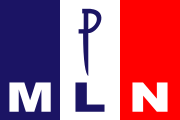National Liberation Movement (Guatemala)
National Liberation Movement Movimiento de Liberación Nacional | |
|---|---|
| President (last) | Fernando Romeo Lucas García |
| Founder | Carlos Castillo Armas |
| Founded | 23 December 1953[1][2] |
| Dissolved | 2 February 2000 |
| Headquarters | Guatemala City |
| Youth wing | Juventud MLN |
| Paramilitary wing | Mano Blanca |
| Ideology | Neo-fascism[3][4][5] Ultraconservatism[6][7] Anti-communism[8] |
| Political position | Far-right[9][10][11][12] |
| International affiliation | World League for Freedom and Democracy |
| Colours | Blue White Red |
| Slogan | ¡MLN! |
| Party flag | |
 | |
TheNational Liberation Movement(Spanish:Movimiento de Liberación Nacional,MLN) was aGuatemalanpolitical partyformed in 1954 byCarlos Castillo Armas.The party served as political platform for themilitary junta.
History
[edit]The MLN was founded as theNational Democratic Movement(Spanish:Movimiento Democratico Nacional,MDN) in 1954 by PresidentCarlos Castillo Armas.It was the ruling party from 1954 until 1958. The party supported the government of PresidentMiguel Ydígoras Fuentes(1958–1963).[13]
The1963 coupthat saw the government of Ydígoras Fuentes overthrown led to the MLN becoming the main party of the military. Although they were not successful in the presidential election of 1964 their candidate in 1970,Carlos Manuel Arana Osorio,was electedPresident,in coalition with theInstitutional Democratic Party(Spanish:Partido Institucional Democrático,PID). Victory was also secured in the1974 electionwhenKjell Eugenio Laugerud García's candidacy was also endorsed by the PID. However they later broke their alliance with the PID for the1978 elections.Its candidate, former PresidentEnrique Peralta Azurdia,placed second in the election.[14]The party was close to theMANOdeath squad.Another faction of the party, theNational Reformist Movement,split away after the coup although it never became a major factor in electoral politics.[13]
In the1982 election,the MLN's candidate was former vice-presidentMario Sandoval Alarcón,who placed second in what was considered a fraudulent election, followed by acoup d'étatin 1982. For the 1984 elections to theConstitutional Assembly,the party allied with National Authentic Central, another right-wing party, and the 23 seats they won constituted the largest bloc in the assembly, albeit outnumbered by reformist parties. They renewed their alliance with the Institutional Democratic Party for the1985 election.Once more, Mario Sandoval Alarcón was its presidential candidate, and placed fourth in the race while the alliance won 12 seats in Congress. The party faded thereafter: it ran alongside theNational Advancement Frontin1990without much success, winning just 4 seats in Congress. Left to continue alone, it secured less than 1% in 1995 (winning a single seat) and again in 1999 (when it lost representation).[15]
See also
[edit]References
[edit]- ^Canale Nanne, Jorge (2022-04-24)."Historia no contada: Movimiento de Liberación Nacional".El Siglo(in Spanish).Retrieved2023-06-27.
- ^"Guatemala Memoria del Silencio | Programa De Las Naciones Unidas Para El Desarrollo".UNDP(in Spanish).Retrieved2023-06-27.
- ^Esparza, Marcia (October 2017).Silenced Communities: Legacies of Militarization and Militarism in a Rural Guatemalan Town.Berghahn Books.ISBN978-1-78533-688-1.
- ^"UNHCR Web Archive".
- ^Davies, Thomas; Loveman, Brian (October 1997).The Politics of Antipolitics: The Military in Latin America.Rowman & Littlefield Publishers.ISBN978-1-4616-4514-6.
- ^https:// washingtonpost /archive/local/2003/12/08/carlos-arana-osorio-guatemal/68612950-fbeb-474b-8370-fdbe4d92da23/[bare URL]
- ^"Guatemala, Heedful of the U.S., Seems Intent on Honest Election".The New York Times.2 November 1977.
- ^https:// cia.gov/readingroom/docs/CIA-RDP79T00826A000400010029-0.pdf[bare URL PDF]
- ^Kinzer, Stephen (July 1984)."Guatemala Picks Assembly Today".The New York Times.
- ^Kinzer, Stephen (5 November 1985)."Christian Democrat Takes Big Lead in Guatemala".The New York Times.
- ^"El espectro del anticomunismo".
- ^"MLN: Partido anticomunista y de derecha extrema".22 April 2015.
- ^abAmeringer, Charles D.Political Parties of the Americas, 1980s to 1990s: Canada, Latin America, and the West Indies.Greenwood Publishing Group,1992.p. 347.ISBN978-0313274183.
- ^Janda, Kenneth."Guatemala: The Party System in 1950-1954 and 1953-1962."Political Parties: A Cross-National Survey.New York:Free Press,1980, pp. 635-636.ISBN978-0029161203.Archived fromthe originalon September 27, 2007.
- ^Corstange, Daniel M.Guatemala: "The Party System from 1963 to 2000."Political Parties: A Cross-National Survey.New York:Free Press,1980.ISBN978-0029161203.Archived fromthe originalon August 2, 2012.
- National Liberation Movement (Guatemala)
- 1953 establishments in Guatemala
- 2000 disestablishments in Guatemala
- Defunct agrarian political parties
- Conservative parties in Guatemala
- Defunct political parties in Guatemala
- Guatemalan Civil War
- Political parties disestablished in 1999
- Political parties established in 1954
- Anti-communism in Guatemala
